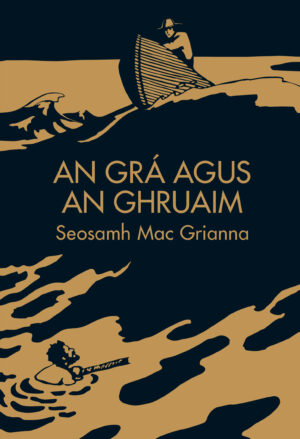Description
In 1845 bhí os cionn ocht milliún duine in Éirinn. Bhíodar beo bocht gan aon deis airgead a shaothrú ná a chur le chéile mar bhí sé go snaidhm an rópa acu na hainchíosa a choinneáil íoctha. Fataí an ghnáthbheatha a bhí acu. Bhí orthu an t-arbhar agus na beithígh a chur sa gcíos. An bhliain chéanna bhuail an smál na fataí agus lobhadar sa talamh. D’fhág sin na daoine gan tada le hithe cé go raibh an tír lán le harbhar ach ba anonn go Sasana a bhí sé seo dhá chur agus cead an diabhail a bheith ag na daoine bochta. Ní raibh acu ach a mbealach a dhéanamh go dtí Teach na mBocht. Aon duine a raibh luach an bhealaigh aige d’imigh sé go Meiriceá. Achar gearr ina dhiaidh seo cuireadh ‘longa cónra’ ar fáil le níos mó daoine a thabhairt anonn. Ní raibh na báid seo déanta le haghaidh paisinéirí. Báid lastais a bhí iontu agus ní ba túisce ná a bheidís ag dul siar folamh líonadh le daoine iad. Ballasta a bhí iontu. Pacáileadh síos faoi dheic iad agus dúnadh na comhlaí orthu. Ifreann ceart a bhí anseo mar bhí easpa aeir, séarachais, beatha agus uisce orthu. I ngeall air seo cailleadh na céadta de bharr fiabhrais agus cheal aeir. Caitheadh na coirp i bhfarraige.
Seo scéal duine acu…cailín beag a tháinig slán. Báthadh an chuid eile… 365 ar fad.
In 1845 there were over eight million people living in Ireland. They were poverty stricken and without any means of improving their financial situation as they were stretched to their limits in trying to pay the high rents charged by landlords. Potatoes were the primary source of nutrition. The other crops like wheat and stocks like cattle were required to pay the rents. That year the potato crops were hit by a plight which left them rotting in the ground. This left the people without anything to eat and although the country was producing plenty of wheat to feed the population, these crops were being sent to England and the poor in Ireland were left in desperation. The only option was to go to the poorhouses. Anyone who had enough money went to America. Shortly after the first months of the famine, boats which came to be known as ‘coffin ships’ started to make regular trips across the Atlantic to bring more people across to America and Canada. These boats were cargo boats and not suitable for carrying passengers. The people on the ships were like ballast in the belly of the boat. They were packed in below deck and the doors closed and bolted above them for the long journey across the ocean. It was pure hell for the people on board. Without sewage facilities, proper ventilation, food or water, many people died before ever reaching their destination due to fever and sickness. These bodies were thrown overboard without ceremony.
This person tells the story of a little girl who survived her journey in a coffin ship to Canada. All the other of the 365 people on board perished.






Reviews
There are no reviews yet.